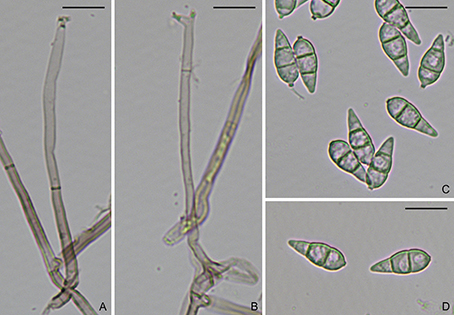
Figure. Pyricularia pennisetigena (CBS138604). A–B. Conidiophores. C–D. Conidia. Scale bars: A–D = 20 µm.
Pyricularia pennisetigena Klaubauf, M.-H. Lebrun & Crous, Stud. Mycol. 79: 114 (2014).
MycoBank: MB810221.
On CMA with sterile rice seed, hyphae branched, septate, hyaline, smooth, 1.5–2.5 μm diam. Conidiophores solitary, erect, straight or curved, unbranched, 2–3-septate, medium brown, smooth, 85–150 × 3.5–6 μm. Conidiogenous cells integrated, terminal or intercalary, light brown, smooth, 30–88 × 3–5.5 μm, with several protruding denticles, 1–1.5 × 1–2 µm. Conidia solitary, pyriform to obclavate, 2-septate, light brown, smooth, 26–30.5 × 9–11 μm, with a truncate hilum, 0.5–1.5 × 1–2 µm.
Colonies on 5 cm diam PDA after 7 days at 25 °C in dark; surface fuscous black with grey center, broad white rim, flat, erose; reverse brown. Colonies on MEA 4.8 cm diam after 7 days at 25 °C in dark; surface cottony to velvety, buff, smoke grey, with broad white rim; reverse iron grey with pale margin. Colonies on CMA 5 cm diam after 7 days at 25 °C in dark; surface buff with grey dots. Colonies on OA 5 cm diam after 7 days at 25 °C in dark; surface buff (Description from Klaubauf et al., 2014).
Typification: Holotype CBSH21844. Ex-holotype culture CBS138604 (ML0036).
Gene sequences: KM484935 (ITS), KM485225 (ACT), KM485294 (CAL), KM485153 (RPB1).
Specimens examined: Mali, Cinzana, on Pennisetum, 19 Sep. 1990, J.L. Nottéghem, culture CBS138604.
Hosts/substrates: On Cenchrus ciliaris, C. echinatus, Echinochloa colona, and Pennisetum (Poaceae).
Distribution: Brazil, Japan, Mali, Philippines, USA.
Copyright 2022 by The American Phytopathological Society. Reproduced, by permission, from Luo, J., and Zhang, N. 2022. The Rice Blast Fungus and Allied Species: A Monograph of the Fungal Order Magnaporthales (https://my.apsnet.org/APSStore/Product-Detail.aspx?WebsiteKey=2661527A-8D44-496C-A730-8CFEB6239BE7&iProductCode=46826). American Phytopathological Society, St. Paul, MN.